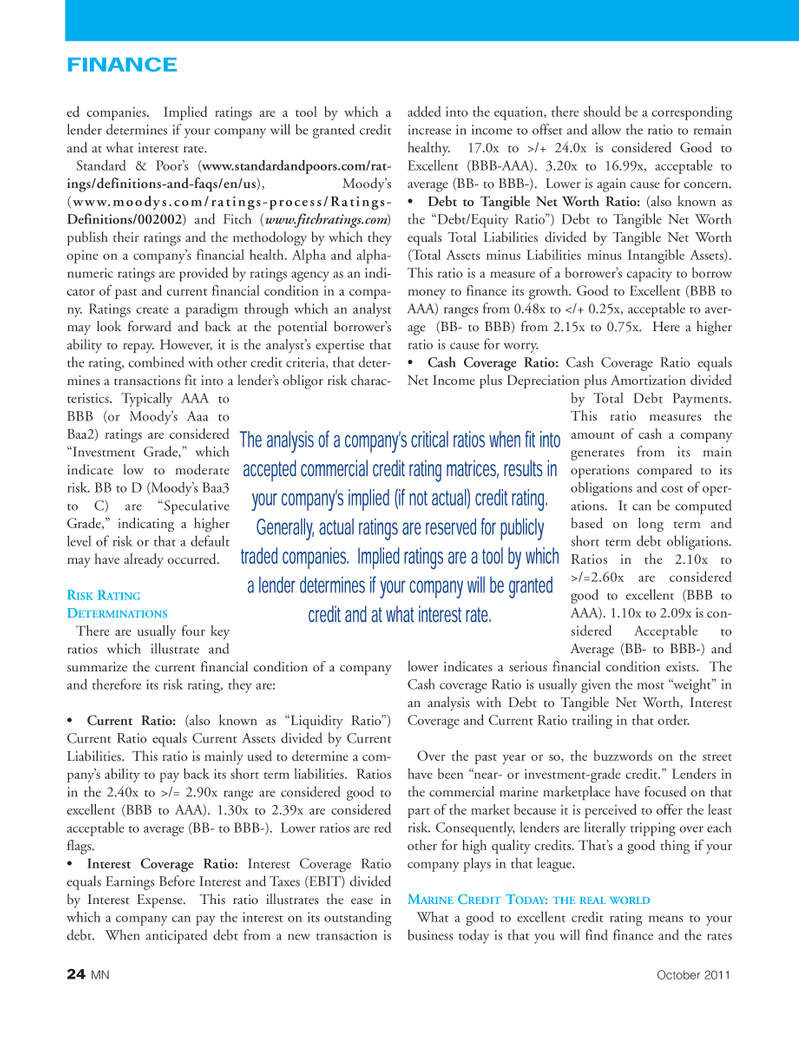
Page 24: of Marine News Magazine (October 2011)
The Yearbook
Read this page in Pdf, Flash or Html5 edition of October 2011 Marine News Magazine
24MNOctober 2011ed companies. Implied ratings are a tool by which a lender determines if your company will be granted credit and at what interest rate. Standard & Poor?s ( www.standardandpoors.com/rat- ings/definitions-and-faqs/en/us), Moody?s (www.moodys.com/ratings-process/Ratings- Definitions/002002 ) and Fitch ( www.fitchratings.com )publish their ratings and the methodology by which they opine on a company?s financial health. Alpha and alpha- numeric ratings are provided by ratings agency as an indi- cator of past and current financial condition in a compa- ny. Ratings create a paradigm through which an analyst may look forward and back at the potential borrower?s ability to repay. However, it is the analyst?s expertise that the rating, combined with other credit criteria, that deter- mines a transactions fit into a lender?s obligor risk charac- teristics. Typically AAA to BBB (or Moody?s Aaa to Baa2) ratings are considered ?Investment Grade,? which indicate low to moderate risk. BB to D (Moody?s Baa3 to C) are ?Speculative Grade,? indicating a higher level of risk or that a default may have already occurred. RISKRATING DETERMINATIONS There are usually four key ratios which illustrate andsummarize the current financial condition of a company and therefore its risk rating, they are: Current Ratio: (also known as ?Liquidity Ratio?) Current Ratio equals Current Assets divided by Current Liabilities. This ratio is mainly used to determine a com- pany?s ability to pay back its short term liabilities. Ratios in the 2.40x to >/= 2.90x range are considered good to excellent (BBB to AAA). 1.30x to 2.39x are considered acceptable to average (BB- to BBB-). Lower ratios are red flags.Interest Coverage Ratio: Interest Coverage Ratio equals Earnings Before Interest and Taxes (EBIT) divided by Interest Expense. This ratio illustrates the ease in which a company can pay the interest on its outstanding debt. When anticipated debt from a new transaction is added into the equation, there should be a corresponding increase in income to offset and allow the ratio to remain healthy. 17.0x to >/+ 24.0x is considered Good to Excellent (BBB-AAA). 3.20x to 16.99x, acceptable to average (BB- to BBB-). Lower is again cause for concern. Debt to Tangible Net Worth Ratio: (also known as the ?Debt/Equity Ratio?) Debt to Tangible Net Worth equals Total Liabilities divided by Tangible Net Worth (Total Assets minus Liabilities minus Intangible Assets). This ratio is a measure of a borrower?s capacity to borrow money to finance its growth. Good to Excellent (BBB to AAA) ranges from 0.48x to /=2.60x are considered good to excellent (BBB to AAA). 1.10x to 2.09x is con-sidered Acceptable to Average (BB- to BBB-) and lower indicates a serious financial condition exists. The Cash coverage Ratio is usually given the most ?weight? in an analysis with Debt to Tangible Net Worth, Interest Coverage and Current Ratio trailing in that order. Over the past year or so, the buzzwords on the street have been ?near- or investment-grade credit.? Lenders in the commercial marine marketplace have focused on that part of the market because it is perceived to offer the least risk. Consequently, lenders are literally tripping over each other for high quality credits. That?s a good thing if your company plays in that league.MARINECREDITTODAY : THEREALWORLD What a good to excellent credit rating means to your business today is that you will find finance and the rates FINANCEThe analysis of a company?s critical ratios when fit into accepted commercial credit rating matrices, results in your company?s implied (if not actual) credit rating. Generally, actual ratings are reserved for publicly traded companies. Implied ratings are a tool by which a lender determines if your company will be granted credit and at what interest rate. MN#10 (18-31):MN 2011 Layouts 10/5/2011 1:51 PM Page 24

 23
23

 25
25
